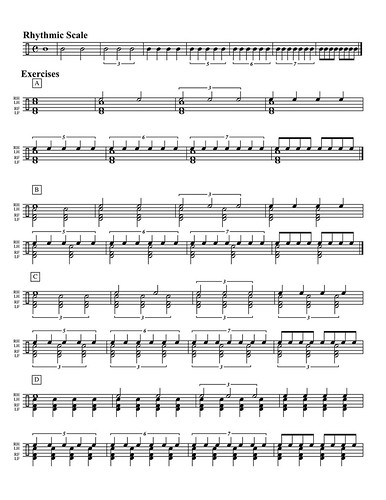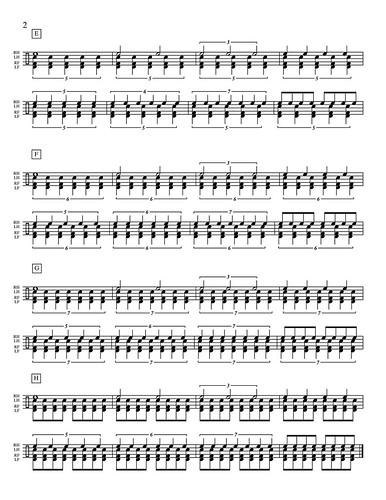

CLICK ON THE PICS FOR A DOWNLOADABLE VERSION
Hopefully, if you follow this blog with any sort of regularity, you caught my last lesson post. If so, I hope you've been working on the Rhythmic Scale...it'll come in handy...starting now...
For years I was in awe of drummers that could use rhythms to suggest different time signatures than they were playing...or to even go beyond a suggestion and actually function in a different time signature while still keeping their place in the tune. The list could be a mile long but some quick examples would be Tony Williams, Antonio Sanchez, Bill Stewart, Dave Weckl, Vinnie Colaiuta...and hundreds of others. The following exercises were some that I devised to help me work on this. I will preface this with saying...this takes a LONG, LONG, LONG time to master...I don't even have all of this stuff down quite yet. Polyrhythms are tricky by themselves, much less learning to play the polyrhythm AND function in both times that you're playing. I'll explain the exercises and then tell you some things I learned that helped me with this along the way.
DISCLAIMER: I felt this needed to be said...NONE OF THESE EXERCISES ARE MEANT TO EVER BE PLAYED OUTSIDE OF THE PRACTICE ROOM!!! These aren't "licks" or fills used to impress...They're a carefully thought out series of exercises aimed at improving your timing, facility on the drumset, and coordination...They are a means to an end, not an end in themselves...in other words, these exercises exist to help you work on your coordination and skills. Application will come later. If you try to play one of these exercises on an actual gig, I swear I may show up and punch you in the face...if the bass player hasn't already, that is...
LESSON 2: Lots and lots of Polyrhythms...
The first thing you see above is the Rhythmic Scale that I gave you last lesson...I put it there simply for reference. Below that you'll see that every degree of the scale is broken down into a section...A-H, or Scale degrees 1-8. Once you can play the subdivisions comfortably in the Rhythmic Scale, it's time to move onto the exercises. When you've mastered both pages, you will be able to play all possible two-limb polyrhythms within the rhythmic scale. After you master these, we can move onto more advanced counting exercises and start to explore how to implement these ideas into your playing.
*In these exercises, all combinations of two or more rhythms, whether unison or contrasting, will be referred to as "polyrhythms" for the ease of explanation.*
Before each line of music you'll notice some abbreviations w/ each line representing a limb of your body: RH(right hand), LH(left hand), RF(right foot), and LF(left foot).
1. Starting with Section A: you'll be playing unison notes with your LH, RF, and LF and your RH will be playing the rhythmic scale from degree 1 all the way to degree 8 (pretty much as written). Again, put repeat signs after every measure and loop each measure until you're comfortable with that particular combination. Section A is simply for you to get your bearings... 1 is your constant, or your check pattern if you want to think of it in those terms. Set your metronome to 4/4 time and get to practicing whats written.
2. After you master Section A, move onto Section B...it gets hairy from here on out. In Section B you'll encounter the polyrhythms 1 against 2, 2 against 2, 3 against 2, 4 against 2, 5 against 2, 6 against 2, 7 against 2, and 8 against 2. You'll notice that the first measure in Section B is the same polyrhythm that's in the second measure of Section A, 1 against 2 (Just flipped upside down). In other words, these exercises have a cumulative effect...once you get to Section E, you'll already know half of it (1 against 5 from Section A, 2 against 5 from Section B, 3 against 5 from Section C, and 4 against 5 from...you guessed it, Section D).
You want to focus on really giving each note its proper value...that's of the utmost importance.
3. After you can play through a section, you'll need to focus on your counting. Play it through and try to count whatever subdivision your playing with your RH. When you can do that, try to count the subdivision you're playing w/ your other three limbs (the constant or check pattern)...the point here is to become completely comfortable with counting each separate rhythm while simultaneously playing another rhythm. Not easy in the least.
4 Once you can play AND count each section, it's time to switch limbs. Instead of playing the Rhythmic Scale w/ your RH we'll switch to playing it with your LH and playing the unisons with your RH, RF, and LF.
5. After you've mastered all w/ your LH, move the Rhythmic Scale to your RF and start all over.
6. And yes, you guessed it, after you've mastered it w/ your RF, move it to your LF.
Before each line of music you'll notice some abbreviations w/ each line representing a limb of your body: RH(right hand), LH(left hand), RF(right foot), and LF(left foot).
1. Starting with Section A: you'll be playing unison notes with your LH, RF, and LF and your RH will be playing the rhythmic scale from degree 1 all the way to degree 8 (pretty much as written). Again, put repeat signs after every measure and loop each measure until you're comfortable with that particular combination. Section A is simply for you to get your bearings... 1 is your constant, or your check pattern if you want to think of it in those terms. Set your metronome to 4/4 time and get to practicing whats written.
2. After you master Section A, move onto Section B...it gets hairy from here on out. In Section B you'll encounter the polyrhythms 1 against 2, 2 against 2, 3 against 2, 4 against 2, 5 against 2, 6 against 2, 7 against 2, and 8 against 2. You'll notice that the first measure in Section B is the same polyrhythm that's in the second measure of Section A, 1 against 2 (Just flipped upside down). In other words, these exercises have a cumulative effect...once you get to Section E, you'll already know half of it (1 against 5 from Section A, 2 against 5 from Section B, 3 against 5 from Section C, and 4 against 5 from...you guessed it, Section D).
You want to focus on really giving each note its proper value...that's of the utmost importance.
3. After you can play through a section, you'll need to focus on your counting. Play it through and try to count whatever subdivision your playing with your RH. When you can do that, try to count the subdivision you're playing w/ your other three limbs (the constant or check pattern)...the point here is to become completely comfortable with counting each separate rhythm while simultaneously playing another rhythm. Not easy in the least.
4 Once you can play AND count each section, it's time to switch limbs. Instead of playing the Rhythmic Scale w/ your RH we'll switch to playing it with your LH and playing the unisons with your RH, RF, and LF.
5. After you've mastered all w/ your LH, move the Rhythmic Scale to your RF and start all over.
6. And yes, you guessed it, after you've mastered it w/ your RF, move it to your LF.
The great thing about these exercises is that you don't necessarily have to be at a drumset to practice them. You can practice them at a red light, during commercials while you're watching tv, while listening to the radio...you can incorporate them into your lifestyle. This really helps because you're wanting these to become second nature. You want 5 over 7 to eventually be as easy to count, subdivide, and play as 2 over 3 is.
we'll stop here for now...this will take you a LONG time...I know it did for me.
The hardest subdivisions are 5 and 7. They're not a normal occurence in popular music, therefore our ear isn't accustomed to hearing them and naturally dividing a beat or measure into 5 or 7 equal parts. The only reason the others are easier is because we're used to hearing them...it takes some time and LOTS of patience to subdivide some of these.
You may be saying "That's impossible! I can't play 3 over 4, much less 5 over 7, or 6 over 5, or whatever!"
I thought that at first too, but the more I dealt w/ and tried to count all of these polyrhythms, the more natural they became to my ear.
Again, a HUGE thanks to Shane Kelly, musician virtuoso, for voluntarily transcribing my chicken scratch into clean documents...
Stop by the FB page, Twitter page, or just comment here if you have any questions...
we'll stop here for now...this will take you a LONG time...I know it did for me.
The hardest subdivisions are 5 and 7. They're not a normal occurence in popular music, therefore our ear isn't accustomed to hearing them and naturally dividing a beat or measure into 5 or 7 equal parts. The only reason the others are easier is because we're used to hearing them...it takes some time and LOTS of patience to subdivide some of these.
You may be saying "That's impossible! I can't play 3 over 4, much less 5 over 7, or 6 over 5, or whatever!"
I thought that at first too, but the more I dealt w/ and tried to count all of these polyrhythms, the more natural they became to my ear.
Again, a HUGE thanks to Shane Kelly, musician virtuoso, for voluntarily transcribing my chicken scratch into clean documents...
Stop by the FB page, Twitter page, or just comment here if you have any questions...

0 comments:
Post a Comment